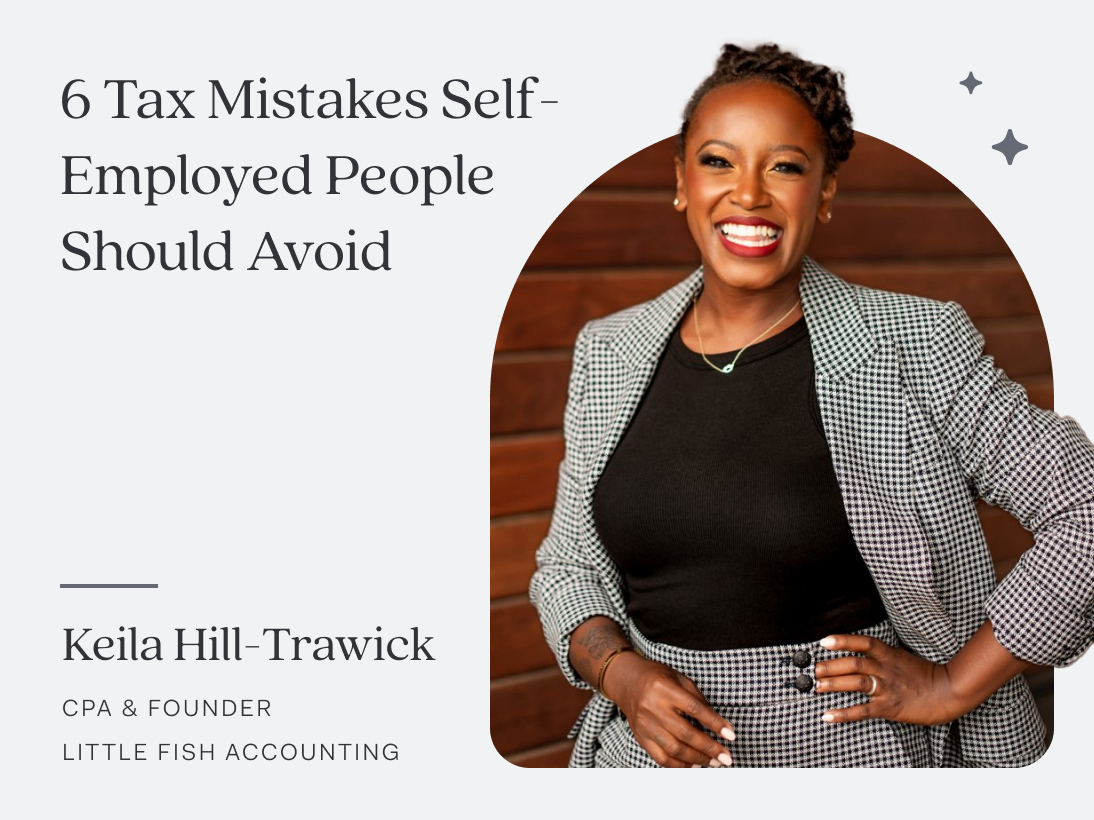The Ultimate Guide to Self-Employment Taxes
We’re all familiar with taxes. However, most of us are only familiar with one kind of tax—income tax.
As a self-employed person, you’re still responsible for paying income taxes. Additionally, you’re also required to pay what is known as self-employment tax. Self-employment tax is a tax that combines Social Security taxes and Medicare taxes. This ensures that everyone contributes to these government programs (W-2 employees have these taxes taken out of their paychecks automatically).
The self-employment tax rate is 15.3%. This is made up of two parts: 12.4% goes toward social security, and the remaining 2.9% goes toward Medicare. Collectively, these are known as FICA taxes—FICA stands for Federal Insurance Contributions Act.
If you’ve ever worked as an employee, you may notice that the self-employment tax is more than what you’re used to paying for Social Security and Medicare. That’s because W-2 employees split these taxes with their employees, while self-employed people are responsible for both portions (you are the employer, after all).
What Taxes Are Self-Employed Individuals Responsible For?
We’ve established what self-employment taxes are—but how much do you owe?
IRS guidelines for self-employment taxes
Anyone who’s made at least $400 in net earnings from self-employment is required to pay the self-employment tax. This is true whether you made that money from a side hustle, a full-time freelancing career, a small business, or any other form of self-employment.
How much do I owe?
The amount you’ll owe the IRS depends on your total net income from self-employment. That means the money you make minus your expenses (more on this below).
For example, let’s say you make $50,000 in self-employed income and have $10,000 in expenses. That means your taxable income is $40,000. If you take 15.3% of $40,000, you get $6,120 in self-employment taxes owed to the IRS.


When to File Taxes
Everyone files taxes at the same time, whether self-employed or not. This means you’ll still file an annual tax return at the same time as everyone else. However, there is a difference between filing taxes and paying taxes. As a self-employed person, you’re responsible for making quarterly estimated tax payments.
These payments are exactly what they sound like—you estimate how much you think you’ll owe in taxes for the quarter and make the payment. Then, when you file your annual return, you’ll file against these estimated payments. If you underestimated, you’d owe some additional tax money, but if you overestimated, you’d actually get a refund.
It’s important to note that if you don’t make these estimated payments, you’ll owe a penalty—0.5% of the total amount owed for each month unpaid. So, for example, if you don’t pay any quarterly taxes, your penalty will be 6% of the total taxes you owe. Quarterly payment deadlines for 2024 estimated tax payments are:
April 15, 2024
June 17, 2024
September 16, 2024
January 15, 2025
Common Tax Forms
The most common tax forms used by self-employed individuals are:
Schedule C: Schedule C (Form 1040) is used to report income or loss from a business or any money you made as a sole proprietor. This is the primary form you’ll use to file your taxes each year.
Schedule SE: Schedule SE (Form 1040) is used to report your self-employment taxes for Social Security and Medicare.
Form 1040-ES: This form is used to calculate your estimated quarterly tax payments. You can use the vouchers included with it to mail in a payment, or make it online using the Electronic Federal Tax Payment System (EFTPS).
How to File Taxes as a Self-Employed Individual
The general process of filing your taxes as a self-employed person is similar to a W-2 employee. However, there are a few additional things you’ll want to consider to minimize the amount you’ll pay. Here’s the general process.
1. Add up your income
Your first task is to determine how much money you actually made. While you won’t pay taxes on this entire amount, it provides the starting point for determining how much you will pay.
Ideally, you’ve been keeping solid records of your income throughout the year. You can use these to add up your income. If you haven’t been keeping records, you can use the 1099 forms that you receive from customers to get close, but keep in mind that not every customer will send one, particularly if you’re below the $600 threshold, and even if they do, it isn’t guaranteed to be accurate. It’s always a good idea to keep your own records.
2. Calculate your expenses
Once you’ve added up your income, the next thing you’ll want to do is determine your expenses for the year. You’ll deduct these expenses from your gross income to determine how much you’re responsible for paying taxes on.
Some of the most common categories of expenses you can claim include advertising, software, office expenses, and bank fees—but there are plenty more.
Keeping accurate records throughout the year can greatly simplify this process—and it’ll certainly be much less stressful than trying to do it all at once with a tax deadline looming. This is also an area where the right software can make a huge difference by automatically categorizing expenses and providing running totals for each.
3. Fill out your forms
Next, gather the tax forms you’ll need. At a minimum, you’ll need form 1040, Schedule C and Schedule SE.
1040 is the standard tax form for individuals—you’re probably familiar with it already.
Schedule C is a form for sole proprietors or other people with self-employed income. You use it to report your business income and expenses. The net profit from line 31 on Schedule C gets carried to form 1040 and also to Schedule SE. Schedule SE is then used to calculate your self-employment taxes—the 15.3% paid to Social Security and Medicare.
These two forms get attached to form 1040 when you file your taxes, these two forms get attached to form 1040 and they’re all submitted to the IRS together.
Ways to Save on Taxes
There are a number of ways you can reduce your tax liability as a self-employed person—primarily through write-offs. These come in the form of business expenses and other purchases you make that are necessary for operating your business. We touched on a few above, but here’s a more comprehensive list:
Advertising
Vehicle expenses, including mileage
Commissions and fees, including bank fees
Contract labor
Insurance, including health insurance
Mortgage or rent—you can even take a percentage of your home mortgage if you have a home office
Office expenses, including things like supplies and furniture
Repairs and maintenance on equipment or office space
Travel and meals
Of course, the IRS has strict guidelines and rules around exactly what you can write off from each category. It’s also important to ensure you have records and receipts you can point to as proof of the expenses. However, it’s a fantastic way to get your taxable income down and thus, reduce the amount you owe the IRS.
FAQs
What taxes do self-employed people pay?
Self-employed people are responsible for the normal income taxes that everyone has to pay. Additionally, they must pay what’s known as the “self-employment tax.” This tax covers payments to Social Security and Medicare and totals 15.3% of taxable income.
How much should I put away for self-employment tax?
As a general rule of thumb, freelancers and self-employed people should set aside about 25–30% of their income for taxes. This amount may seem like a lot, but it’s plenty to cover both the self-employment tax and income taxes. Setting aside a bit of extra money ensures that you’ve got enough when it’s time to make payments, and if you end up overpaying you can even get a refund.
Why is the self-employed tax so high?
Self-employment taxes seem high because you’re paying both the employer and employee portion. W-2 employees split the tax with their employer in the form of payroll taxes.
File in Style with Found
Self-employed taxes can feel confusing and stressful. However, they don’t have to be. By following these simple directions and keeping good records, you can get a handle on the process and file with confidence.
If you really want to get your taxes under control, give Found a try and take the guesswork out of taxes. Found’s tax tools help you run your business with newfound clarity and ease. No more toggling between costly apps; sign up for free.
Planning to use tax prep software this tax season? Save up to an additional 20% off when you file with TurboTax*.

Disclaimer: The information on this website is not intended to provide, and should not be relied on, for tax advice. Found partners with TurboTax, and is not a filing service. *Restrictions may apply, see TurboTax terms.
Related Guides

6 Tax Mistakes Self-Employed People Should Avoid
Accounting and Taxes
17 Self-Employed Tax Deductions for Freelancers and Small Business Owners
Accounting and Taxes2024 Tax Deadlines for the Self Employed
Accounting and Taxesfor the self-employed
*Found is a financial technology company, not a bank. Banking services are provided by Piermont Bank, Member FDIC. The funds in your account are FDIC-insured up to $250,000 per depositor for each account ownership category.
The Found Mastercard Business debit card is issued by Piermont Bank pursuant to a license from Mastercard Inc.
The information on this website is not intended to provide, and should not be relied on, for tax advice.
Direct deposit funds may be available for use for up to two days before the scheduled payment date. Early availability is not guaranteed.
